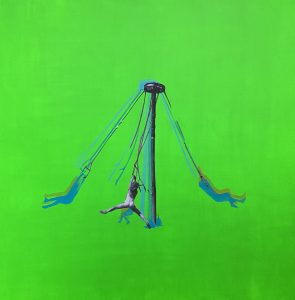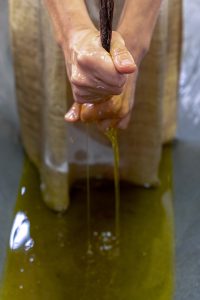An all-female collective that for some time now has been turning its attention to emerging Italian and international art, with particular attention to artistic interpretations of current debates and forms of activism. This is a.topos, a cultural association led by Lucia Trevisan and Fernanda Andrade, who in the heart of Venice present a new event dedicated to a more than ever necessary reflection on the post-pandemic future. The exhibition Utopia, Dystopia is the first appointment of a series that is part of the second edition of THE CREATIVE ROOM, a call for artists dedicated to the theme “The Future of Art and the Art of the Future”. The spaces of SPARC*, the Venetian gallery and home of the VeniceArtFactory project, for this occasion host the works of the artists: Mário Afonso, Damiano Fasso (Italy), Lina Zylla (Germany), Sève Favre (Switzerland), Sarah Valente (France), Doris Schamp (Austria), Madalena Corrêa Mendes (Portugal), Armin Amirian (Iran), Lucrezia Costa (Italy), Oona Nelson (USA), Constanza Camila Kramer Garfias (Chile), Jia-Rey Chang (Taiwan), Elena Xausa & Lorenzo Fonda (Italy), Nero Cosmos (Switzerland).
The narrative starts with the work of the American artist Oona Nelson (San Francisco, 1961), whose practice consists of burning still life paintings, reproductions of masters, symbols in the past of wealth and worldly pleasures. The act, a symbol for the artist of the decline of civilisation and of an inexorable future towards extinction, has led Nelson to burn eighty paintings to date. The video installation The perfect world by Damiano Fasso (Montecchio Maggiore, 1976), filmed in Italy and China, with video and audio by the artist, shows the visitor a succession of images of fairground rides and fairs, evoking a moment of play, serenity and inner lightness. The gradual appearance of flashing signs and the music accompanying the video slowly reveal the artist’s true message: a criticism of a society that invites the waste of resources and excessive consumerism.
Austrian artist and cartoonist Doris Schamp (Oberpullendorf, 1983) presents a drawing of a human body outlined by a thick black line, which only at a close distance reveals to the viewer a game of graphic cutouts and non-random shapes: Hang in there! is a naked body at someone’s mercy, trapped by a banded structure, referable to bondage, a metaphor for the power and domination that can affect human beings in various situations, from pandemic to global warming to the more recent war in Ukraine. Elena Xausa‘s 3D printed sculpture Sundial with Lorenzo Fonda reflects on time in the age of the anthropocene, when the Earth is the victim of a human being who shapes and scans everything around him with his own hands; the work does not hide the pop and colourful style typical of Xausa, already known for her international collaborations in the world of illustration.
Costanza Camila Kramer Garfias (Viña del Mar, 1988) is a Chilean artist who trained in Germany and later in Japan, where she lived with Japanese masters and learned from them the traditional techniques of creating natural pigments from plants. Proof of her talent for combining art, textiles and philosophical theories is her creation Autobahn, in jacquard fabric and metal chains, which raises questions about the reproduction of viruses and their development over generations. The work of the German performer Lina Zylla (Munich, 1986) consists of a performance, Finding the Wind’s Direction, which took place in a rural Italian landscape in the year 2021; a film project supported by the Yong Art and New Ways programme of the Free State of Bavaria and the Gisela and Erwin von Steiner Foundation, in which some detailed and close-up shots of glass and its pictorial realisation in relation to inclined glass in nature can be seen. Born and grown up in Iran, Armin Amirian (Isfahan, 1995) is a self-taught artist who sees art as the universal medium for communication, “where nothing matters but the truth and honesty you put into all aspects of creation”. Small black and white windows on a region scarred by conflict and war, Amirian’s photographs tell the story of everyday life in his Middle East in no uncertain terms, triggering curiosity and amazement in the visitor.
The series Unspoken bond – returning to favour by Roman artist Lucrezia Costa is a documentation in ten photographs of an act of restitution by the artist: after having “asked” the landscape to lend her some earth to create natural bricks for the performance La casa vivente at Mudec in Milan, Costa felt she had to return the favour, bringing back what she had taken away after using it. A hidden and unspoken link between artist and landscape. The works of Sarah Valente (Paris, 1988) aim to show a hidden and invisible side of the world, to which we often do not give due attention: the infinite richness of the forest and its inhabitants. With Jungle I – Canpy Mapping, Valente presents a series of works on paper and oil colour with an intervention of pigment that allows certain shapes to be perceived through ultraviolet light. An exceptional reflection on Canopia and the vision of insects, which can distinguish fluorescent signs in the infinite abundance of the forest. Taiwanese artist Jia-Rey Chang (Taipei, 1982), a designer and researcher whose reflections focus on space as a living being, is the author of Monitoring Room, an immersive and interactive virtual reality work – presented here as a video installation – that asks the question “What is reality?”, with the intention of investigating the current issue of monitoring and manipulation of information and personal data, due to the advent of the internet and social media.
The artistic path of Nero Cosmos (Bern, 1964), a conceptual artist based in Zurich, experiments with artificial intelligence, creating images and videos in a constant state of metamorphosis; the video in the exhibition, Urbanization, process of changing, explores the process of change in urban areas and its visual translation through artificial intelligence and algorithms. Sève Favre (1975), an artist originally from Sion, focuses her investigation on the concepts of integration and interaction between the viewer and the work of art: by means of an original installation (Amazing Robin IV) consisting of an image broken down into various paper boxes, with its digital twin in an ipad placed to the side, each user present has the opportunity to create his or her own personal idea of a visual work, by moving the boxes physically on the paper work or digitally in the technological support. In the case of the latter there is the possibility of sending it by email or sharing it on the media with the hashtags #interaisproject and #interagisgif. The exhibition concludes with the work A Hug by Madalena Corrêa Mendes, a Portuguese artist who involves the viewer in the creation of an alternative, reinvented and borderless geographical map that can be cut, torn and rebuilt, demonstrating that we are the real builders of our future.
Between multiple interpretations of reality and utopian and despotic visions of the human future, the exhibition brings together works that together form an expanded horizon: Utopia, Dystopia is an immersion in readings that are optimistic in some ways and devastating in others, prognoses of a cynical and uncertain destiny, analyses of various aspects of an everyday reality that we will have to appreciate, and many other visions in which art demonstrates its power in the future of humanity.
Info:
Utopia, Dystopia
Exhibition curated by a.topos Venice
in collaboration with Portrait Eyewear and Demoni Danzanti Residenza Artistica
03-13/03/2022
SPARC*, Campo Santo Stefano, San Marco 2828a, 30124,Venezia
Free Entrance
Opening hours: Tuesday – Sunday, 10am – 6pm
For further information contact: info@atoposvenice.com
 Damiano Fasso, The perfect world, 2020, Video Pal, Color, 1_28, courtesy the artist
Damiano Fasso, The perfect world, 2020, Video Pal, Color, 1_28, courtesy the artist
 Daniela di Lullo, Spleen, 2021, acrylic painting and photographic collage on canvas, 50 X 50 cm, courtesy the artist
Daniela di Lullo, Spleen, 2021, acrylic painting and photographic collage on canvas, 50 X 50 cm, courtesy the artist
 Armin Amirian, Analogy-01, 2012 Digital C Print, Fine Art Photography 50 x 70 cm, limited edition of 5+2, courtesy the artist
Armin Amirian, Analogy-01, 2012 Digital C Print, Fine Art Photography 50 x 70 cm, limited edition of 5+2, courtesy the artist
Lucrezia Costa, Unspoken bond – returning a favor, 2021, series of 10 analogic photographs documenting performance (Photography by Matteo Cariddi), inkjet print on cardboard, 10 x 15cm each, unique prints, courtesy the artist
 Veronika Dräxler, Medea, 2021, performance documented as HD video, courtesy the artist
Veronika Dräxler, Medea, 2021, performance documented as HD video, courtesy the artist
Independent curator specialized in Argentine art, with studies and publications on the subject (“Argentina at the Venice Biennale of Art” in Storie della Biennale di Venezia, Ed. Ca’ Foscari, 2020), founder in 2014 of arteargentina.it, the first Italian platform dedicated to Argentine art in Italy. She currently collaborates in Venice with galleries and artists.






NO COMMENT